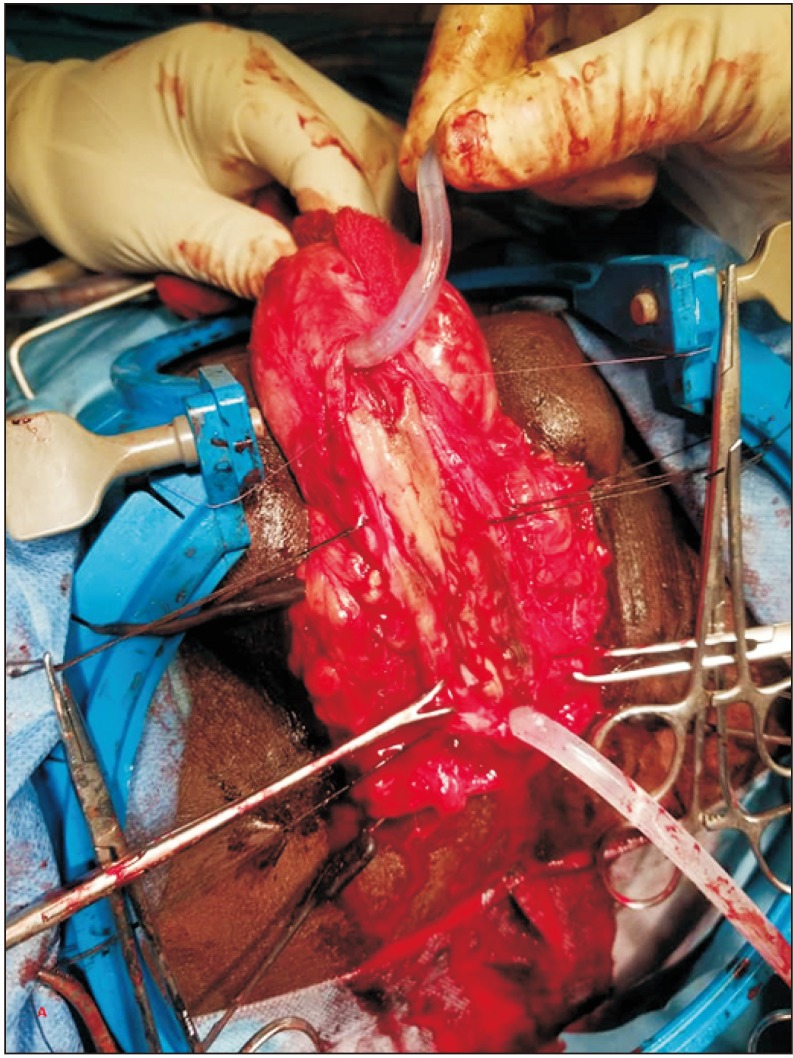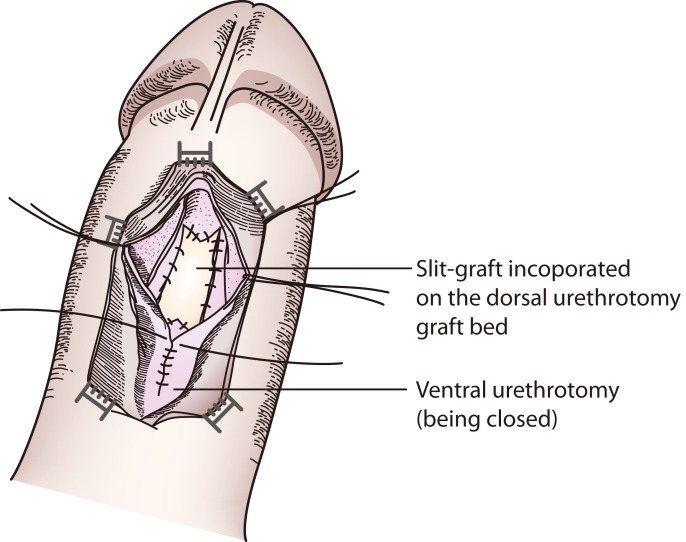1. Schlossberg SM. A current overview of the treatment of urethral strictures: etiology, epidemiology, pathophysiology, classification, and principles of repair. In : Schreiter F, Jordan GH, editors. Reconstructive urethral surgery. Heidelberg: Springer;2006. p. 59–65.
2. Brandes SB. Epidemiology, etiology, histology, classification, and economic impact of urethral stricture disease. In : Brandes SB, editor. Urethral reconstructive surgery. Totowa: Humana;2008. p. 53–61.
3. Datta B, Rao MP, Acharya RL, Goel N, Saxena V, Trivedi S, et al. Dorsal onlay buccal mucosal graft urethroplasty in long anterior urethral stricture. Int Braz J Urol. 2007; 33:181–186. discussion 186–7. PMID:
17488537.

4. Abdulwahab AA, Mustapha K, Mbibu NH, Maitama HY, Ojo EO. Perineo-penile degloving exposure in Quartey's urethroplasty: a preliminary report. J Surg Tech Case Rep. 2009; 1:9–14.
5. Gupta NP, Ansari MS, Dogra PN, Tandon S. Dorsal buccal mucosal graft urethroplasty by a ventral sagittal urethrotomy and minimal-access perineal approach for anterior urethral stricture. BJU Int. 2004; 93:1287–1290. PMID:
15180624.

6. Eltahawy EA, Virasoro R, Schlossberg SM, McCammon KA, Jordan GH. Long-term followup for excision and primary anastomosis for anterior urethral strictures. J Urol. 2007; 177:1803–1806. PMID:
17437824.

7. Singh O, Gupta SS, Arvind NK. Anterior urethral strictures: a brief review of the current surgical treatment. Urol Int. 2011; 86:1–10. PMID:
20956850.

8. Lee YJ, Kim SW. Current management of urethral stricture. Korean J Urol. 2013; 54:561–569. PMID:
24044088.

10. Kröpfl D, Verweyen A. Indications and limits for the use of buccal mucosa for urethral reconstruction. In : Schreiter F, Jordan GH, editors. Reconstructive urethral surgery. Heidelberg: Springer;2006. p. 195–204.
11. Fichtner J, Filipas D, Fisch M, Hohenfellner R, Thüroff JW. Long-term outcome of ventral buccal mucosa onlay graft urethroplasty for urethral stricture repair. Urology. 2004; 64:648–650. PMID:
15491691.

12. Bhargava S, Chapple CR. Buccal mucosal urethroplasty: is it the new gold standard? BJU Int. 2004; 93:1191–1193. PMID:
15180603.

13. Mungadi IA, Mbibu NH. Current concepts in the management of anterior urethral strictures. Niger J Surg Res. 2006; 8:103–110.

14. Dubey D, Kumar A, Mandhani A, Srivastava A, Kapoor R, Bhandari M. Buccal mucosal urethroplasty: a versatile technique for all urethral segments. BJU Int. 2005; 95:625–629. PMID:
15705092.

15. Elliott SP, Metro MJ, McAninch JW. Long-term followup of the ventrally placed buccal mucosa onlay graft in bulbar urethral reconstruction. J Urol. 2003; 169:1754–1757. PMID:
12686826.

16. Barbagli G, Palminteri E, Guazzoni G, Montorsi F, Turini D, Lazzeri M. Bulbar urethroplasty using buccal mucosa grafts placed on the ventral, dorsal or lateral surface of the urethra: are results affected by the surgical technique? J Urol. 2005; 174:955–957. discussion 957–8. PMID:
16094007.

17. Sawant AS, Savalia AJ, Pawar PW, Patil SR, Kasat GV, Narwade S, et al. An audit of urethroplasty techniques used for managing anterior urethral strictures at a tertiary care teaching institute-what we learned. J Clin Diagn Res. 2018; 12:PC17–PC21.

18. Barbagli G, Guazzoni G, Palminteri E, Lazzeri M. Anastomotic fibrous ring as cause of stricture recurrence after bulbar onlay graft urethroplasty. J Urol. 2006; 176:614–619. discussion 619. PMID:
16813903.

19. Eppley BL, Keating M, Rink R. A buccal mucosal harvesting technique for urethral reconstruction. J Urol. 1997; 157:1268–1270. PMID:
9120917.

20. Barbagli G, Palminteri E, Guazzoni G, Cavalcanti A. Bulbar urethroplasty using the dorsal approach: current techniques. Int Braz J Urol. 2003; 29:155–161. PMID:
15745501.

21. Barbagli G, Selli C, Tosto A. Reoperative surgery for recurrent strictures of the penile and bulbous urethra. J Urol. 1996; 156:76–77. PMID:
8648842.

22. Asopa HS, Garg M, Singhal GG, Singh L, Asopa J, Nischal A. Dorsal free graft urethroplasty for urethral stricture by ventral sagittal urethrotomy approach. Urology. 2001; 58:657–659. PMID:
11711331.

23. Kellner DS, Fracchia JA, Armenakas NA. Ventral onlay buccal mucosal grafts for anterior urethral strictures: long-term followup. J Urol. 2004; 171(2 Pt 1):726–729. PMID:
14713797.

24. Mungadi IA, Ugboko VI. Oral mucosa grafts for urethral reconstruction. Ann Afr Med. 2009; 8:203–209. PMID:
20139540.

25. Martins FE, Kulkarni SB, Joshi P, Warner J, Martins N. Management of long-segment and panurethral stricture disease. Adv Urol. 2015; 2015:853914. PMID:
26779259.

26. Zimmerman WB, Santucci RA. Buccal mucosa urethroplasty for adult urethral strictures. Indian J Urol. 2011; 27:364–370. PMID:
22022061.

27. Angermeier KW, Rourke KF, Dubey D, Forsyth RJ, Gonzalez CM. SIU/ICUD consultation on urethral strictures: evaluation and follow-up. Urology. 2014; 83(3 Suppl):S8–S17. PMID:
24275285.

28. Meeks JJ, Erickson BA, Granieri MA, Gonzalez CM. Stricture recurrence after urethroplasty: a systematic review. J Urol. 2009; 182:1266–1270. PMID:
19683309.

29. Goonesinghe SK, Hillary CJ, Nicholson TR, Osman NI, Chapple CR. Flexible cystourethroscopy in the follow-up of posturethroplasty patients and characterisation of recurrences. Eur Urol. 2015; 68:523–529. PMID:
25913391.

30. Liberman D, Pagliara TJ, Pisansky A, Elliott SP. Evaluation of the outcomes after posterior urethroplasty. Arab J Urol. 2015; 13:53–56. PMID:
26019979.







 PDF
PDF ePub
ePub Citation
Citation Print
Print







 XML Download
XML Download